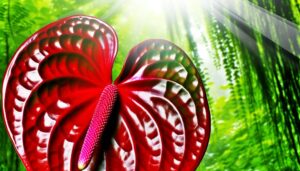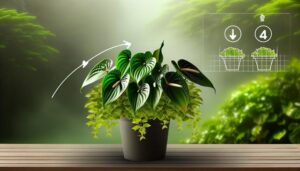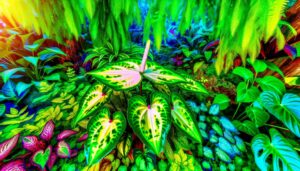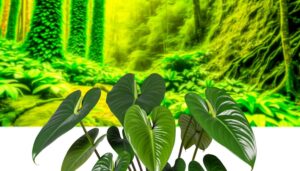Complete Guide to Caring for Anthurium Andraeanum
Anthurium andraeanum thrives in bright, indirect light and requires consistent moisture without becoming waterlogged. Best soil conditions include a well-draining mix rich in organic matter with a slightly acidic pH of 5.5 to 6.5.
Maintain temperatures between 70°F to 85°F and high humidity levels of 70% to 80%. Common challenges include pests like aphids and spider mites, and diseases such as root rot.
Proper drainage, appropriate humidity levels, and regular monitoring are essential. By following these guidelines, Anthurium andraeanum can flourish and continue to produce vibrant blooms, with further details necessary for mastering its care.
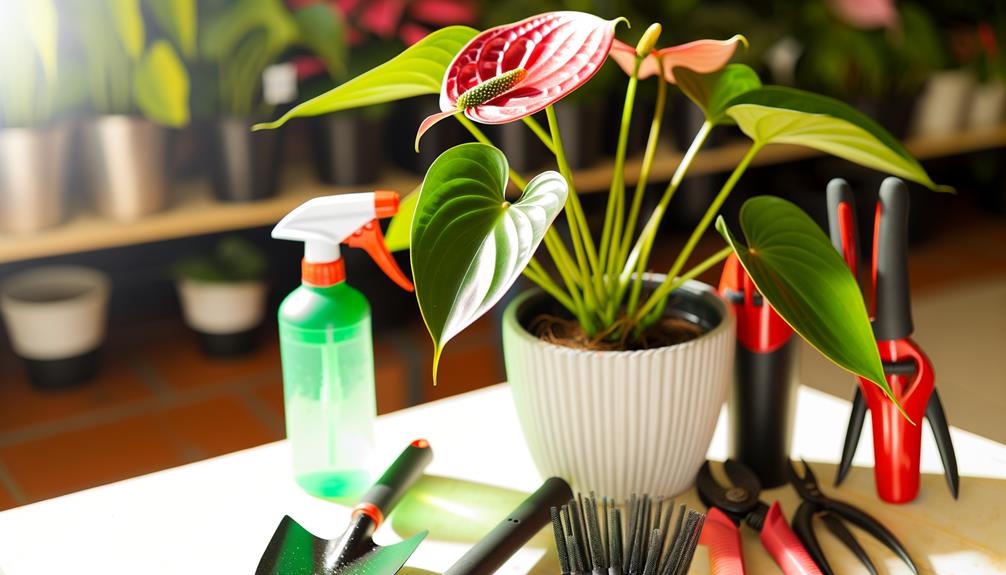
Key Takeaways
- Place Anthurium andraeanum in bright, indirect light near east or north-facing windows.
- Water when the top inch of soil is dry and avoid overwatering to prevent root rot.
- Use a well-draining potting mix with orchid bark, peat moss, and perlite.
- Maintain temperature between 70°F to 85°F and high humidity levels of 70% to 80%.
- Regularly check for pests like aphids, spider mites, and mealybugs, and treat promptly.
Light Requirements
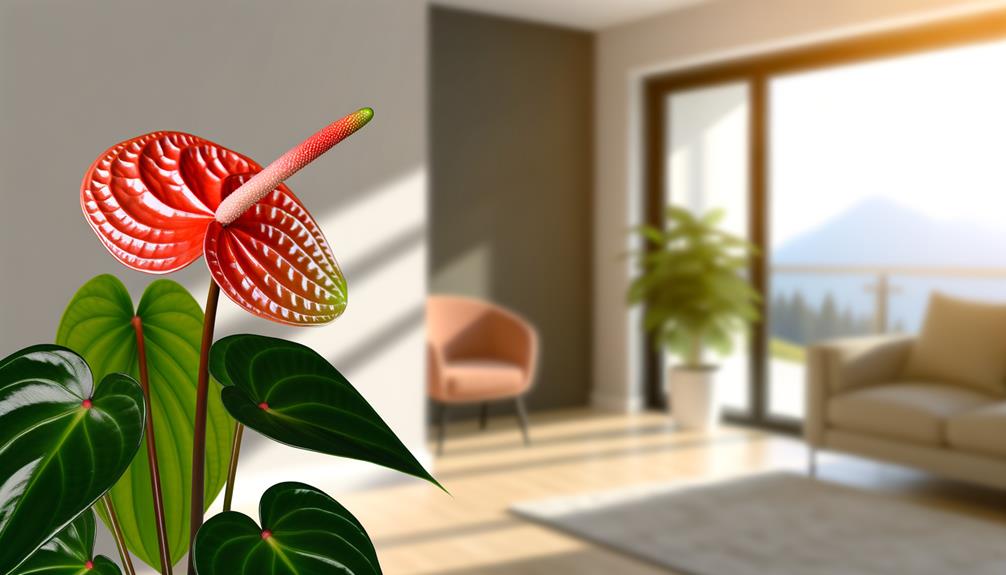
Anthurium andraeanum thrives best in bright, indirect light, as direct sunlight can scorch the leaves and hinder its growth. Ideal conditions involve placing the plant near an east or north-facing window where it can receive ample but diffused light.
Artificial lighting can supplement natural light, particularly in low-light environments, with fluorescent or LED grow lights serving as suitable options. Maintaining consistent light exposure is vital for promoting photosynthesis and ensuring vibrant foliage and blooms.
It is advisable to rotate the plant periodically to guarantee even light distribution, preventing asymmetric growth. Excessive shade can lead to leggy stems and reduced flowering, hence maintaining the balance of light is paramount for healthy development.
Watering Guidelines
Proper hydration is essential for the best growth of Anthurium andraeanum, necessitating a watering regimen that keeps the soil consistently moist but never waterlogged. Watering should be done when the top inch of soil feels dry to the touch.
Utilize room-temperature, filtered, or rainwater to avoid chlorine and fluoride, which can damage the plant. Avoid overwatering by ensuring adequate drainage in the pot, as standing water can lead to root rot.
During the growing season, typically spring through early fall, increase watering frequency while reducing it in the winter months when the plant’s growth slows. Regularly misting the leaves can also help maintain humidity levels, mimicking the plant’s natural tropical environment.
Soil and Potting

To secure optimal growth, the soil for Anthurium andraeanum should be well-draining, rich in organic matter, and slightly acidic, with a pH range of 5.5 to 6.5. A specialized potting mix can be formulated using equal parts of orchid bark, peat moss, and perlite to achieve the desired characteristics. Proper potting ensures that the roots receive adequate oxygen and prevents waterlogging, which can lead to root rot.
Here’s a quick reference table for soil composition:
| Component | Proportion |
|---|---|
| Orchid Bark | 1 part |
| Peat Moss | 1 part |
| Perlite | 1 part |
| Organic Matter | Rich in content |
Correctly potting Anthurium andraeanum in this mix promotes robust growth and vibrant blooms.
Temperature and Humidity
Maintaining a perfect temperature range between 70°F and 85°F (21°C to 29°C) and maximizing high humidity levels of 70% to 80% are essential for the healthy growth of Anthurium andraeanum. These conditions mimic the plant’s natural tropical habitat.
To achieve this:
- Temperature Control: Use a thermostat to sustain the appropriate temperature, avoiding fluctuations that could stress the plant.
- Humidity Maintenance: Employ a humidifier or place the plant on a humidity tray filled with water and pebbles to sustain the required humidity levels.
- Monitoring Tools: Utilize a hygrometer to regularly check humidity levels and optimize they remain within the prime range.
Such meticulous care will foster robust growth and vibrant blooms in your Anthurium andraeanum.
Common Pests and Diseases
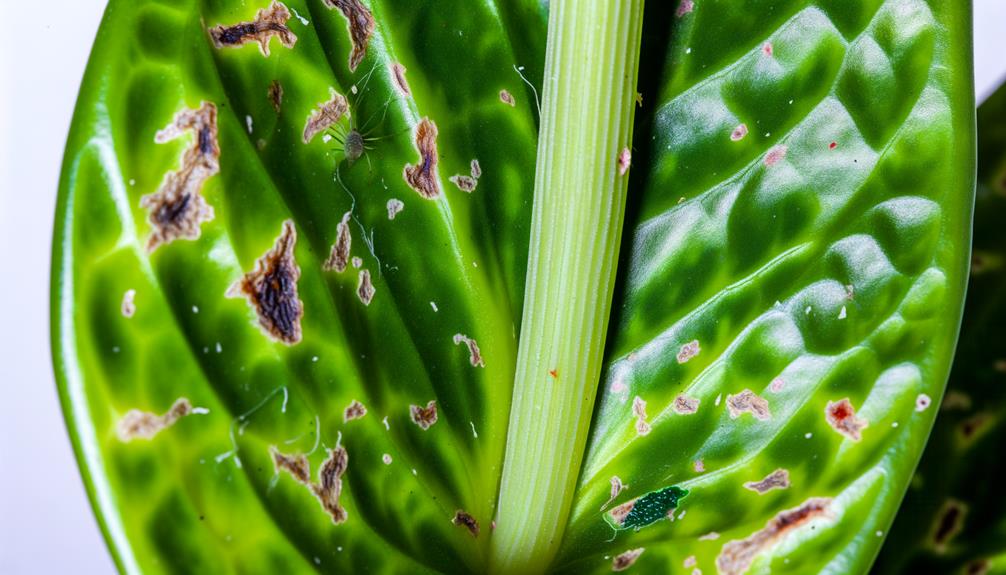
Despite ideal temperature and humidity conditions, Anthurium andraeanum can still be susceptible to various pests and diseases that may impede its growth and overall health.
Common pests include aphids, spider mites, and mealybugs, which can cause leaf discoloration and deformities. These pests can be controlled through regular inspection and the application of insecticidal soap or neem oil.
Diseases such as root rot and bacterial blight are also prevalent, often resulting from overwatering or poor drainage. Root rot manifests as blackened, mushy roots, while bacterial blight causes water-soaked lesions on leaves.
Mitigation strategies include ensuring proper drainage, reducing humidity, and using fungicides or bactericides as necessary.
Conclusion
To sum up, the thorough care of Anthurium andraeanum requires an understanding of its specific needs, including ideal light, accurate watering practices, appropriate soil composition, and suitable temperature and humidity levels. Meeting these requirements promotes healthy growth and vibrant blooms.
Additionally, vigilance against prevalent pests and diseases is crucial. How can one anticipate this stunning plant to prosper without careful focus on these vital factors? Proficiency in these aspects ensures the flourishing of this graceful species.

